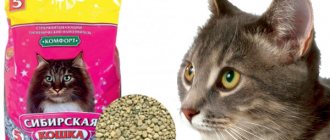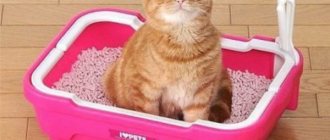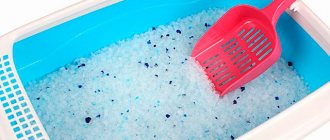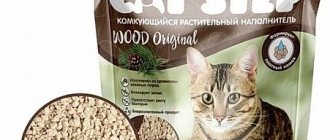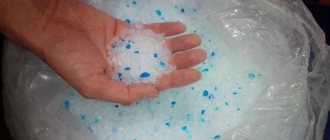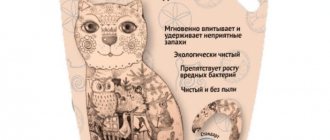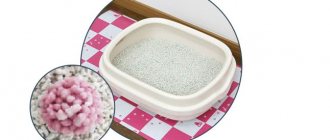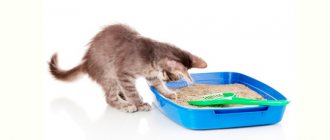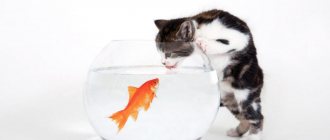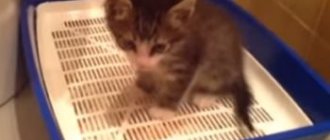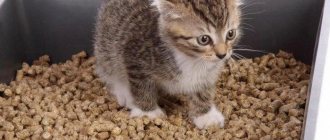Updated: 04/22/2021 17:12:38
Expert: Rudenko Irina Sergeevna
*Review of the best according to the editors of expertology.ru. About the selection criteria. This material is subjective in nature, does not constitute advertising and does not serve as a purchase guide. Before purchasing, consultation with a specialist is required.
A cat tray is an important attribute of keeping your animal clean. The type of litter used largely determines how quickly the animal will get used to its “household,” as well as how convenient it will be for the owners to maintain the tray.
What types of cat litter are there?
The first criterion of difference is composition. Fillers can be:
- Silica gel
is granules made from dried pieces of polysilicic acid, the most economical type of filler, suitable for adult cats; - Clay
is the most natural for animals due to the proximity of the material to natural soil; - Wood
made from pressed sawdust is the most environmentally friendly and does not raise safety concerns.
According to the principle of action, fillers are divided
clumping, when the liquid, absorbing the material, forms a lump; absorbents do not change their structure, but retain moisture and odors.
Experts from the EXPERTOLOGY portal identified the best brands of litter based on the opinions of cat owners, veterinarians and the general characteristics of the materials.
Cat behavior when using the toilet
In some cases, the cat completely refuses to use the toilet and does its business in the most unexpected places, while avoiding the tray itself or using it in an unusual way, for example, sleeping in it.
It is impossible to talk to a cat directly and find out its opinion on this issue, but the animal’s behavior can tell a lot to an attentive and caring owner.
Most cats that do not suffer from mental problems do not show dissatisfaction and go to the toilet with any litter. The exception is when the material contains any compounds that cause allergies in the animal. Then it cannot use its toilet purely physically.
In general, a cat’s requirements for litter can be outlined by the following points:
- the material should not contain any flavorings so that nothing distracts the animal’s keen sense of smell;
- the particles should not rustle loudly, knock or make any loud sounds, since cats prefer not to reveal their location to a hypothetical enemy during such an intimate process;
- It should be comfortable for the cat to dig into the tray; it is best if the filler particles are easily mixed and do not stick to the paws or raise dust;
- it is desirable that the material was natural, at least partially.
All cat owners are familiar with their pet's behavior in the toilet. These animals, with varying degrees of energy, dig out a place for themselves to relieve themselves, and then bury them. This behavior is due to the fact that all domestic cats descend from wild ancestors who were forced to take care of their own safety.
Most mammals on our planet navigate the world around them mainly by smell. Good eyesight or acute hearing are also inherent in some of them, but everyone smells smells, drawing from them the information necessary to choose a behavioral strategy. Excrement can tell a lot about an animal to another member of the fauna.
Domestic cats seem to have no need to perform this ritual and ensure safety, but almost all of them continue to bury their excrement. The cat teaches this to the kitten along with all other skills. It is a fixed behavioral pattern that animals continue to pass on from generation to generation, despite the fact that it has lost its practical value.
In addition, the genes of a cautious predator make cats constantly worry about survival and safety. Even a calm home environment, an always filled bowl does not make them careless, they are always ready to survive in any conditions
And they continue to follow the traditions learned from their mother.
Sometimes cats don't bury their excrement, and that should tell a sensitive owner a lot. There may be several reasons for a change in behavioral pattern. The cat may not hide evidence of his presence for the same reasons that in other conditions he carefully “destroys evidence.” It's about establishing your dominant role.
In most cases, this is due to the fact that there are several animals living in the house, especially if there are two or more mature cats. People call this behavior “marking territory”; it is for this purpose that cats leave their urine, saliva, feces, and rub against corners with glands that secrete odorous substances. This is how they establish their rights.
In some cases, cats stop burying feces for emotional reasons. If there are “clouds gathering” in the house, a difficult emotional situation, cats feel this very keenly. Then their behavior can change greatly, and they stop performing some usual actions, and, on the contrary, begin to behave in an unexpected way.
Quite rarely, but still sometimes cats are simply embarrassed to do their business in front of someone. Of course, the concept of shyness cannot be fully applied to cats. This behavior is due to the fact that when an animal is observed, it does not feel safe.
In such cases, we are not talking about a filler that we don’t like. It may be worth considering purchasing a closed litter box where your pet will be protected from prying eyes.
Rating of the best silica gel fillers
| Nomination | Place | Name | Price |
| The Best Silica Gel Cat Litters | 1 | Fresh Step Crystals | 800 ₽ |
| 2 | Smart Cat | 397 ₽ | |
| 3 | Homecat Silica Gel Standard | 281 ₽ | |
| 4 | N1 Crystals | 257 ₽ | |
| 5 | Cat Step | 295 ₽ | |
| 6 | PRETTYCAT | 125 ₽ | |
| The best clay cat litters | 1 | Ever Clean Multi-Crystals | 770 ₽ |
| 2 | Fresh Step Extreme Clay | 429 ₽ | |
| 3 | Canada Litter Scoopable Baby Powder | 520 ₽ | |
| 4 | Happy paws | 171 ₽ | |
| 5 | Eurolitter Baby Powder | 632 ₽ | |
| 6 | ProNature Holistic | 690 ₽ | |
| 7 | Kotyara | 164 ₽ | |
| The best wood litter for cat litter | 1 | Cat's Best Eko Plus | 350 ₽ |
| 2 | N1 Naturel Green tea | 383 ₽ | |
| 3 | Clean paws Woody | 142 ₽ | |
| 4 | Homecat Wood small granules | 99 ₽ |
Recommendations for selection
The most affordable is wood litter, and most cats respond well to it. A clumping mineral and clay product is considered the most natural. Silica gel is one of the more expensive, but also more economical fillers.
The market is full of offers, so making a balanced and correct choice is especially important. If the animal does not like the filler, it will refuse to use the toilet and will be very distrustful of the new product.
Let's look at the main criteria that need to be taken into account.
Choose filler from well-known companies. In this case, you will be able to accurately understand that the quality and environmental friendliness of the product is controlled by both manufacturers and buyers.
For a kitten, use litter without aromatic ingredients. Experts recommend choosing this option for adult animals as well, because finding a suitable scent can be quite problematic.
Consider the animal's habits. If a cat was accustomed to silica gel in a cattery, then wood filler may cause the cat to refuse the tray.
Choose a product that has the appropriate labeling about the absence of chemical treatments and additives, and about environmental safety
When an animal digs into the litter with its paws, dust enters the respiratory system, and particles enter the digestive system. It is important to ensure the cat’s safety.
When assessing the cost of filler, take into account its cost-effectiveness. A cheap product that needs to be replaced frequently will result in higher total costs than an expensive product that can be replaced less frequently.
The large size of granules is mainly chosen for long-haired adult cats. Fine filler can get stuck in the fur and cause discomfort to the animal.
The Best Silica Gel Cat Litters
Transparent or lightly tinted silica granules vary in size, which is selected based on the size of the cat. The material actively absorbs water, increasing in its own volume, which ensures its efficiency. True, all silica gel fillers must be kept in a dry room in completely sealed packaging, otherwise their effectiveness is reduced due to the absorption of moisture from the air. Also, due to the peculiarity of a significant increase in volume, used crystals cannot be thrown into the toilet - this can lead to blockages.
Fresh Step Crystals
Rating: 4.9
The rating of silica gel fillers opens with the American Fresh Step Crystals - one of the best materials that can cope with unpleasant odors in the cat litter. Moreover, this ability of granules remains up to 30 days when used in accordance with the recommendations.
Fresh Step Crystals are smooth, dust-free granules that do not stick to the paws or injure them, so the house remains clean after the cat goes to the litter box. In addition, the softness of the granules contributes to the animal’s silent stay in the toilet.
The manufacturer recommends pouring a 3.5 cm thick layer of granules into the tray and promptly removing any formed lumps, mixing the remaining material to redistribute unused crystals.
Some users report low odor protection, which may be due to insufficient amount of granules in the tray (for example, a large cat will need more material), using crystals that are already moistened, or health problems in the cat. These disadvantages apply to all types of silica gel fillers.
Advantages
- Smooth granules without sharp edges;
- No dust – up to 99% pure material;
- The particles do not stick to the paws;
- Long-term retention of odors and moisture.
Flaws
- High price from 436 rubles per 1 kg.
Which tray to choose
At first, your kitten will need a litter box with low sides so that he can get in easily.
The container should be large enough for the animal to feel comfortable there and be able to use it more than once. If at the time the kitten appears in the house you have not yet managed to purchase a toilet for it, then an old baking dish or any other box may be perfect for this purpose. There are many varieties of indoor cat litter boxes on the market today, which not every animal wants to use. Experts advise using open trays first. In this case, during the period of accustoming the kitten to it, it will be easier for you to monitor it. Once he gets into the habit of using the litter box, you can place a closed one next to the open container to learn about his preferences. Some animals prefer the privacy of a closed box, while others do not like confined spaces.
If you have several cats, it is best to have one litter box for each of them, plus one extra. In a multi-story building, place a container on each level.
The best wood litter for cat litter
Fine sawdust is one of the most environmentally friendly types of cat litter. In fact, its production is the recycling of waste logging materials. Factories that produce fillers further clean and compress the sawdust using simple installations and package the product in bags. Trees recently felled by the elements may also be involved. This is the main reason for the low price of wood pellets, which, by the way, are more practical than regular sawdust - they do not stick to the paws so intensely, and the pellets crumble only when wet. In any case, the used material will rot in a few years without much effort from nature, which is why fans of eco-products love it.
Cat's Best Eko Plus
Rating: 4.9
The leader among wood litter for cat litter is Cat's Best Eko Plus. It is much more effective than its analogues - up to 700% of the liquid is retained in the capillaries of the wood fibers, which, moreover, block the odor and mask it with its own ether, which makes it possible to clean the tray somewhat less frequently, although it is recommended to do this in a timely manner. No improving additives are used for production, only natural wood, mainly coniferous.
Used Cat's Best Eko Plus can be flushed down the toilet in small quantities - like toilet paper, it completely dissolves in water and does not form sewer blockages (if local waste disposal regulations allow this). In addition, soft sawdust in granules is comfortable for cats’ paws and they go to the tray willingly.
The cost of 1 liter of Cat's Best Eko Plus starts from 86 rubles.
Advantages
- Absolutely environmentally friendly material;
- Can be disposed of in the toilet;
- Cats like it;
- Long-term moisture retention.
Flaws
- He drags himself around the house on his paws.
How to choose a filler
First of all, you have to make a choice between two types of litter: clumping and non-clumping. At the same time, take into account your lifestyle and the physiology of the cat. For example, if you cannot be at home all the time and remove lumps every time your pet goes to the toilet, then buy absorbent litter.
The disadvantage of clumping litter is that you will have to reach for the scoop often.
However, there may be exceptions. In particular, some cat breeders say that their cats go to the toilet strictly on an hourly basis: in the morning, before the owner leaves for work, and in the evening, when he returns. For this case, both types of filler are suitable.
Those who leave home for 2-3 days, for example, on a visit or to the country, should pay attention to silica gel filler. But again there may be options. Some cat lovers provide their cat with 5 trays with a simple absorbent filler. By the time they return, at least one of them remains more or less clean. So any tandem, cat plus owner, is individual. You will have to decide according to the circumstances.
Clumping litter is ideal for programmable automatic toilets. At a specified time or immediately after the cat leaves the litter box, the cleaning program starts. Special rakes, a sieve or a scoop automatically remove lumps into the built-in container.
Having decided on the type of filler, you can begin to select the material from which it is made. If the cat or owner is prone to allergies, then wood or corn fillers are suitable. Dusty clay ones attract few people; they can only be poured into toilet houses. Everyone should try silica gel to have personal experience with the most advanced product in this field.
If a cat constantly uses poor quality clay litter and inhales the dust that rises when digging during each trip to the toilet, then he may develop swelling of the respiratory tract.
Video: veterinarian advice on choosing litter
The next step is to search for your favorite brand in the category of fillers that you have chosen. Keep in mind that different types of litters are sold under the same brand: absorbent, clumping, wood, clay, silica gel, etc. While you and your cat are searching, buy small packages and test for 1-2 weeks. Draw conclusions: which filler needs to be replaced less often, is the quality comparable to the price. Leave the cat the right to interrupt the experiment on the first day by refusing to use the new litter.
Your pet has the right to refuse the litter you like
The choice is also influenced by factors such as the age and gender of the pet. There are litters that are only suitable for kittens, but when used by an adult cat they do not absorb odors well and do not eliminate odors. In addition, the smell of a cat or kitten is not as strong as cat amber. A litter that is ideal for one pet may not be suitable for another.
Clumping
The operating principle of clumping litters is simple: when liquid gets in, a dense lump is formed, which is easy to remove with a scoop. The rest of the mass remains dry. A new portion is poured into the vacant space.
Any clumping cat litter is poured into a tray in a layer of at least 7 cm, preferably ─ 10-12 cm. A tray with high sides curved inward is most suitable.
The size of the granules should be chosen based on the age of the pet and the length of the coat. Small granules are suitable for kittens, small animals and cats with sensitive skin. Representatives of long-haired breeds – medium or large pellets.
Large granules have poorer absorption capacity.
Advantages:
- Convenient to remove clumps from the tray.
- Holds moisture well and eliminates odor.
- Suitable for all breeds.
Flaws:
- They can't hold the smell for long.
- Do not dispose of in sewer.
- If you don't change it regularly, there will be a lot of debris and dust.
The granules are completely replaced every week.
Clay
Bentonite cat litter is readily available, environmentally friendly, and cat-friendly. Bentonite is a certain type of clay that can absorb liquid 14-16 times its volume and form dense lumps. There are flavored and odorless, with large and small particles.
Advantages of clay filler:
- Cats love clay litter because it is easy to dig into.
- It is easy to remove formed lumps from the tray.
- Absorbs odor and can absorb a lot of liquid.
- Animals are most easily accustomed to the clay toilet.
- Cost effective since only the crumpled part is replaced.
Flaws:
- May stick to the bottom if the substrate layer is small.
- Lumps need to be removed constantly.
- Sticks to paws, fur, and spreads throughout the house.
- Both the pet and the owner may be allergic to clay dust.
- Cannot be used on kittens, as they like to try everything by tooth.
- When stored in high humidity conditions it becomes damp.
How good a bentonite clay backfill will be depends largely on the quality of the raw materials. There is an economical option - the clay is chemically treated, the granules do not absorb well, generate dust, and a more expensive, but high-quality option - basically pure clay without impurities.
Filler requirements
Before choosing cat litter, you need to take into account both the wishes of the owner and the requirements of the pet.
An ideal product for a cat meets a number of criteria:
- It was possible to dig in it.
- Stepping on granules (pellets) did not hurt.
- There was no dust, otherwise the cat would start sneezing or develop an allergy.
- Natural smell. Flavorings are for humans.
- Harmless to digestion.
A person wants order in the apartment and puts as little effort as possible into cleaning, including the cat’s bathroom.
The owner has his own requirements:
- Completely odorless.
- Does not stick to paws or fur.
- It is used economically.
- Safe for pets.
- Ideally, it is flushed down the toilet.
